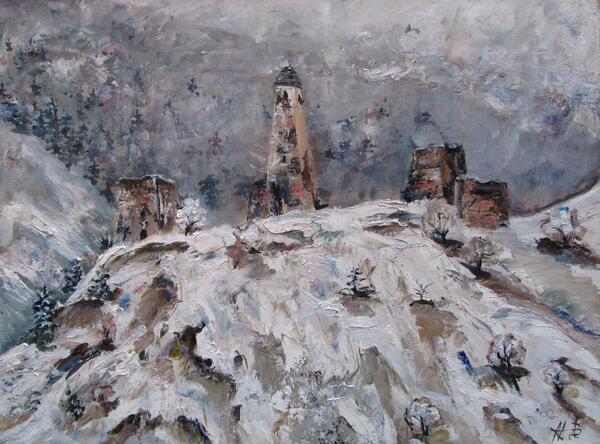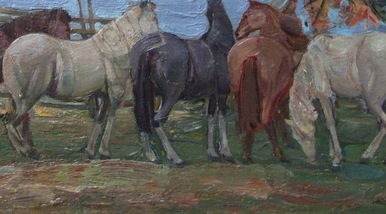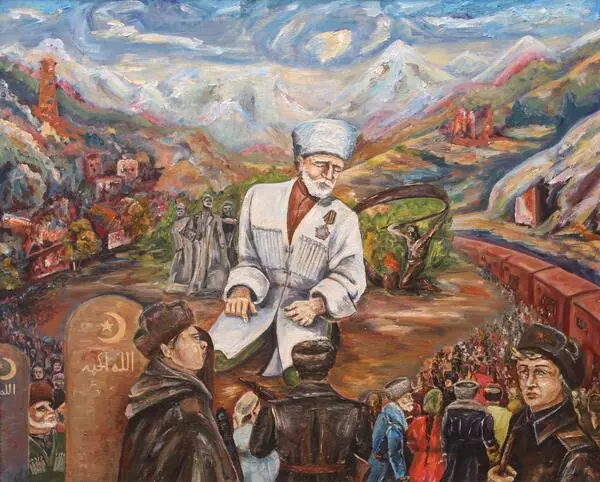The painting “Barkin” which is housed in the Memorial Complex of Glory was painted by artist Issa Aushev in 1996. It is a winter mountain landscape.
The artist placed a snow-covered hilltop in the center of the composition, on which four stone Vainakh buildings stand apart from each other. The Vainakh peoples are an ethnic community of peoples and nationalities of the North Caucasus. A residential tower rises between the buildings.
Such tower settlements were characteristic of the Ingush highlanders. There are about 150 small settlements in the Dzheyrakhsky District alone, which consisted entirely of stone towers: residential, combat (military) or semi-combat towers. They were built to fight off attackers, survive during clan wars and protect families and livestock from predators.
The endoethnonym, or self-name, Vainakh, appeared in the early 20th century. The Chechen and Ingush, who speak Nakh languages, referred to themselves as the Vainakh. The name was popularized by linguistic scholars, and later was used by the peoples themselves.
In historical literature, researchers might sometimes refer to the ancestors of the Chechen and Ingush, as well as to two separate ethnic groups, the Akkin and Arshtins, as Vainakhs. Presently, the Vainakh peoples live mainly in the Chechen Republic and the Republic of Ingushetia.
Issa Aushev was born on February 4, 1958 in the village of Galashki, Sunzhensky District, Ingushetia. He graduated from an eight-year school and entered the Fine and Graphic Arts Department of the North Ossetian Pedagogical School in 1973.
His first exhibition was held in a military unit: from 1977 to 1980, Aushev served in the Soviet Armed Forces in Czechoslovakia. In 1980, he was awarded the Medal “Brotherhood in Arms”.
Aushev’s work was influenced by Murad Polonkoev, a People’s Artist of the Russian Federation. They traveled together to paint en plein air, organized and held exhibitions. In 1993, Issa Aushev became head of a children’s art school in the Sunzhensky District of the Republic of Ingushetia.
In his paintings Aushev always creates a clear composition, applies color with wide brushes, builds general color combinations and transitions, but he always carefully selects the shades. In his works, he avoids deliberate decorativeness and strives to truthfully represent the nature of the mountains and the human place in it.
The artist placed a snow-covered hilltop in the center of the composition, on which four stone Vainakh buildings stand apart from each other. The Vainakh peoples are an ethnic community of peoples and nationalities of the North Caucasus. A residential tower rises between the buildings.
Such tower settlements were characteristic of the Ingush highlanders. There are about 150 small settlements in the Dzheyrakhsky District alone, which consisted entirely of stone towers: residential, combat (military) or semi-combat towers. They were built to fight off attackers, survive during clan wars and protect families and livestock from predators.
The endoethnonym, or self-name, Vainakh, appeared in the early 20th century. The Chechen and Ingush, who speak Nakh languages, referred to themselves as the Vainakh. The name was popularized by linguistic scholars, and later was used by the peoples themselves.
In historical literature, researchers might sometimes refer to the ancestors of the Chechen and Ingush, as well as to two separate ethnic groups, the Akkin and Arshtins, as Vainakhs. Presently, the Vainakh peoples live mainly in the Chechen Republic and the Republic of Ingushetia.
Issa Aushev was born on February 4, 1958 in the village of Galashki, Sunzhensky District, Ingushetia. He graduated from an eight-year school and entered the Fine and Graphic Arts Department of the North Ossetian Pedagogical School in 1973.
His first exhibition was held in a military unit: from 1977 to 1980, Aushev served in the Soviet Armed Forces in Czechoslovakia. In 1980, he was awarded the Medal “Brotherhood in Arms”.
Aushev’s work was influenced by Murad Polonkoev, a People’s Artist of the Russian Federation. They traveled together to paint en plein air, organized and held exhibitions. In 1993, Issa Aushev became head of a children’s art school in the Sunzhensky District of the Republic of Ingushetia.
In his paintings Aushev always creates a clear composition, applies color with wide brushes, builds general color combinations and transitions, but he always carefully selects the shades. In his works, he avoids deliberate decorativeness and strives to truthfully represent the nature of the mountains and the human place in it.




